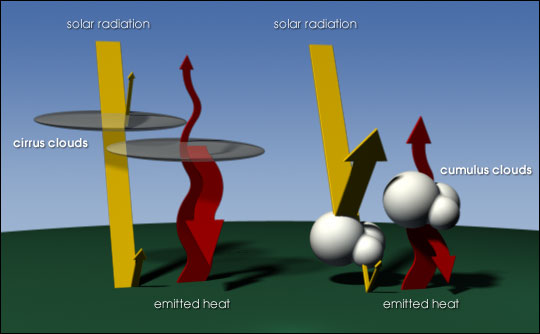

 | |||
Climatologists working under the stark fluorescent lighting and controlled conditions of a laboratory rarely have the luxury of directly studying Mother Nature. They cannot bring a slice of El Niño back to the bench to observe its movements. Nor can they encase a natural ecosystem in Pyrex and heat it up to see what happens. Climatologists must study firsthand the ongoing changes in the Earth’s climate system in all its chaos and mystery. |
Part 1: The Iris Hypothesis
| ||

Possibly no part of the climate system is more unpredictable than the interaction between atmospheric water and radiation emitted by the Sun and the Earth. At any given time, a small sea of water floats above our heads in the form of clouds, ice, and water vapor. The form and position the water takes in the sky changes the way it interacts with solar and thermal radiation. Clouds, especially low-lying, thick clouds, reflect an enormous amount of sunlight back into space and keep it from overheating the Earth. High-flying, wispy clouds and water vapor absorb greater amounts of outgoing thermal (heat) radiation, which is generated by the surface of the Earth after it is warmed by the Sun. Along with greenhouse gases, such clouds and water vapor contribute to keeping the average temperature of the Earth’s surface from dropping to Arctic levels year round. |
High, thin cirrus clouds are almost transparent, in contrast to thicker cumulus clouds, which are opaque to sunlight. Changes in the relative amounts of these clouds affect the amount of energy from the Sun that is absorbed by the Earth. (Photograph copyright Reto Stöckli) | ||
| |||
Due to its delicate interplay with energy, atmospheric water has tremendous potential to impact the Earth’s climate and temperature. For years, researchers have been attempting to pin down the complex interactions involved. Specifically, they’d like to know in what way clouds and water vapor might shift if the surface of our planet were to warm further due to elevated levels of human-generated greenhouse gases. In attempts to forecast possible future scenarios, scientists have created numerous computer models to simulate the interactions between clouds and radiation. Particular attention has been given to the tropics because more sunlight hits these latitudes than anywhere else. Resulting theories and model results have run the gamut. Some researchers profess that in the future, thick, low-lying clouds will decrease and high-flying cirrus clouds will increase, making global warming much worse. Others espouse theories, such as the Iris Hypothesis, which state that as the Earth’s surface heats up, cirrus clouds will dissipate and allow more thermal energy to vent into space, countering the effects of global warming. |
Seen from space, the difference between cumulus and cirrus clouds is striking. On the left are the bright white cumulus towers of thunderstorms. On the right, thin cirrus clouds are partially transparent. (Space Shuttle Photographs STS084-706-69 and STS032-88-69 courtesy NASA JSC Gateway to Astronaut Photography of the Earth) | ||
 | |||
The problem, however, is that relatively little real-world data have been collected to test these theories or even to build exacting computer models. Since clouds are constantly shifting, separating, growing, and shrinking, the only way to study them and their effects on radiation has been through the use of remote sensing instruments and weather satellites. Such instruments have been around for about 25 years. Only recently have scientists acquired enough data to put together any meaningful conclusions. Last year, a group of researchers led by Bruce Wielicki and Tak Wong, climate scientists at NASA’s Langley Research Center, compiled a couple decades worth of radiation data from the tropics. While the researchers approached the data with the idea of testing existing notions, they witnessed a phenomenon no one expected. Over the past 15 years, progressively more thermal radiation has been escaping the atmosphere above the tropics and progressively less sunlight has been reflecting off of the clouds. Though researchers now believe that wind currents throughout the tropics have been fluctuating and altering clouds and radiation patterns, the discovery has brought many theories and climate models into question. The data used in this study are available in one or more of NASA's Earth Science Data Centers. |
The Earth’s energy balance refers to the amount of energy received from the sun (yellow arrows) minus the energy reflected and emitted from the Earth (red arrows). Clouds play an important role in regulating this balance. Thin cirrus clouds permit sunlight to pass through them, while blocking a significant amount of the heat radiating from the surface. Thick cumulus clouds reflect most sunlight, and block the majority of heat radiating from the surface. (Illustration by Robert Simmon, Earth Observatory) | ||